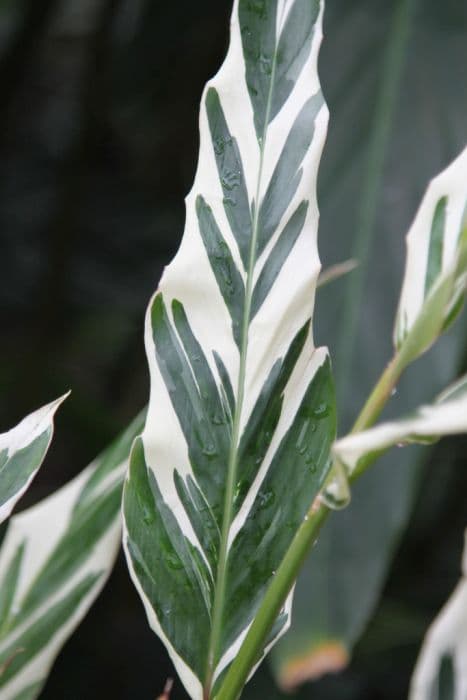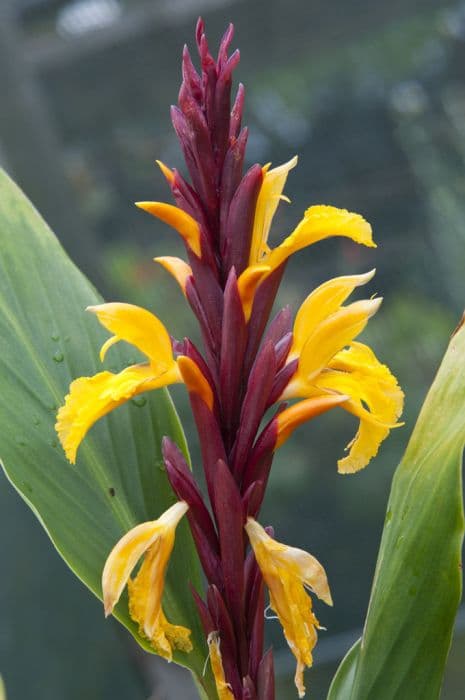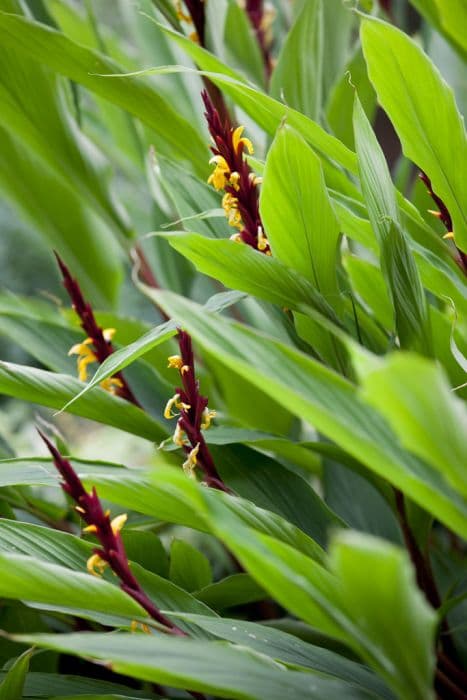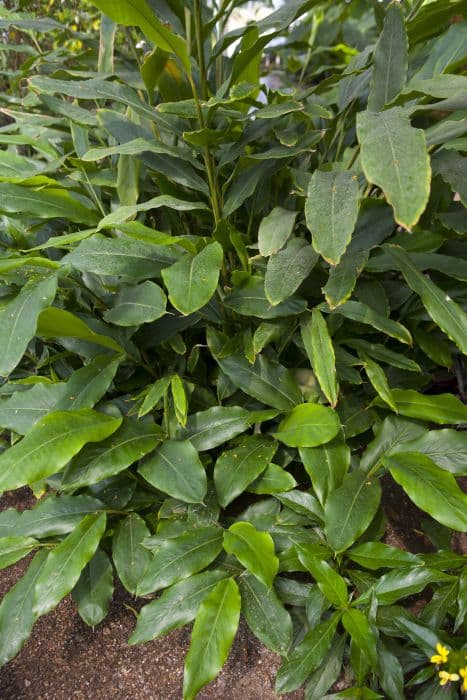Kew Beauty Roscoea cautleyoides 'Vanilla'

ABOUT
The plant known as Vanilla Roscoea showcases a unique and attractive appearance. It is adorned with a set of lush green leaves that have a distinctive shape, often elongated with a pointed tip, similar to that of spearheads. As a prominent feature, this plant produces stunning flowers that are a sight to behold. These flowers are delicate and come in a soft, creamy vanilla color, living up to the 'Vanilla' in its name. The petals of the blooms are gently curved, contributing to their sophisticated and elegant look. Adding to its beauty, the Vanilla Roscoea has a lower lip that stands out among the petals, often having a slightly different shade or markings that draw the eye. The blossoms of this plant can hold significant appeal for those who enjoy subtle and nuanced floral displays in their gardens or as part of their landscape. Despite its striking appearance, it maintains a certain simplicity that makes it versatile in various garden settings without overwhelming the space with too much color or complexity.
About this plant
 Names
NamesFamily
Zingiberaceae.
Synonyms
Cautleya Roscoea, Ginger Cautleya, Hardy Ginger, Himalayan Ginger, Yellow Roscoea.
Common names
Roscoea cautleyoides 'Vanilla'.
 Toxicity
ToxicityTo humans
There is currently no widely recognized evidence indicating that Roscoea cautleyoides, commonly known as the ginger family plant, is toxic to humans. Consequently, there are no specific symptoms associated with poisoning from this plant listed in general literature or major toxicology resources. However, as with any plant, individual allergies or reactions can occur, and it is always recommended to exercise caution and avoid ingesting plants that are not commonly recognized as food sources.
To pets
There is currently no widely recognized evidence indicating that Roscoea cautleyoides, commonly known as the ginger family plant, is toxic to pets. As such, there are no specific symptoms associated with poisoning from this plant listed in common veterinary toxicology resources. However, it is always advisable to prevent pets from consuming non-food plants since individual reactions can vary, and what is non-toxic for human might not be safe for animals.
 Characteristics
CharacteristicsLife cycle
Perennials
Foliage type
Deciduous
Color of leaves
Green
Flower color
Yellow
Height
1-2 feet (30-60 cm)
Spread
0.5-1 foot (15-30 cm)
Plant type
Herb
Hardiness zones
6
Native area
Himalayas
Benefits
 General Benefits
General Benefits- Aesthetic Appeal: Adds beauty and visual interest to gardens with its vanilla-colored, orchid-like flowers.
- Attracts Pollinators: Invites beneficial insects like bees to the garden, aiding in pollination of crops and flowers.
- Easy to Grow: Low maintenance requirements make it suitable for a range of gardeners, from beginners to experts.
- Cold Hardy: Exhibits resilience in cooler temperatures, making it a good choice for temperate climates.
- Rare Variety: Provides a unique and exotic look due to its relative rarity in gardens compared to more common varieties.
- Compact Size: Its relatively small size allows it to fit well in smaller gardens or as part of container arrangements.
- Seasonal Interest: Offers late spring to early summer blooms, contributing to the seasonal dynamics of a garden's visual display.
 Medical Properties
Medical PropertiesThis plant is not used for medical purposes.
 Air-purifying Qualities
Air-purifying QualitiesThis plant is not specifically known for air purifying qualities.
 Other Uses
Other Uses- Roscoea cautleyoides 'Vanilla', commonly known as ginger lily, can be used as a natural fabric dye, providing a range of subtle yellow to green hues depending on the mordant used.
- The rhizomes of ginger lily can be crushed and added to homemade potpourri for a unique, pleasant fragrance.
- Dried ginger lily flowers can be incorporated into paper making, adding botanical elements and texture to the finished product.
- The leaves of the ginger lily can be shaped into temporary eco-friendly garden labels by writing on them with a marker before they fully degrade.
- Ginger lily's robust leaves can serve as natural wraps for small garden bouquets or as creative wraps for eco-friendly gift presentation.
- In regions where ginger lily is abundant, its sturdy stalks may be used to create a simple, natural garden trellis for supporting other climbing plants.
- Children can use the hollow stems of ginger lily for educational purposes, such as studying plant structure or practicing botanical illustration.
- The plant's unique flower shape can inspire botanical-themed art projects, serving as a model for drawing, painting, or sculpture activities.
- During seasonal celebrations, ginger lily can contribute to a natural garden centerpiece, showcasing its exotic flowers to create a tropical ambiance.
- The ginger lily can be used in landscape photography to add depth and interest to garden scenes or to practice macro photography techniques on its intricate flowers.
Interesting Facts
 Feng Shui
Feng ShuiThe plant Roscoea is not used in Feng Shui practice.
 Zodiac Sign Compitability
Zodiac Sign CompitabilityThe plant Roscoea is not used in astrology practice.
 Plant Symbolism
Plant Symbolism- Rarity: Roscoea cautleyoides 'Vanilla', commonly known as Ginger lily, is not a widely known or common plant, which can symbolize uniqueness or rarity in one's life.
- Exotic Beauty: With its beautiful flowers, the Ginger lily might be seen as a symbol of exotic beauty, representing the allure of the unusual and the appreciation of aesthetic qualities.
- Adaptability: As the plant can adapt to various conditions, Ginger lily could symbolize the ability to thrive in diverse environments and situations.
- Serenity: The soft 'Vanilla' color of this variant of Ginger lily might convey a sense of calm and peacefulness, similar to the calming effect of the vanilla scent.
 Water
WaterThe Vanilla Orchid needs consistent moisture during active growth in spring and summer; typically, it should be watered once a week. However, it's important to allow the top inch of soil to dry out slightly before watering again to prevent root rot. Each watering should thoroughly saturate the soil, which might require around half a gallon of water, depending on the size of the container and the plant's environment. During the winter, reduce watering to every other week, or whenever the soil is mostly dry.
 Light
LightVanilla Orchid prefers bright, indirect light and should be placed in a spot where it receives diffused sunlight, such as near an east-facing or north-facing window, or a few feet away from a south-facing or west-facing window. Direct sunlight, especially in the hotter parts of the day, should be avoided as it can cause leaf scorch.
 Temperature
TemperatureThe Vanilla Orchid thrives in temperatures between 60 and 75 degrees Fahrenheit, but it can tolerate a range from 50 to 85 degrees Fahrenheit. This plant prefers consistent temperatures and should be protected from drafts and extreme temperature fluctuations which can stress the plant.
 Pruning
PruningPruning the Vanilla Orchid is generally done to remove dead or yellowing leaves and to shape the plant for aesthetic purposes or to control its size. The best time to prune is after the plant has finished flowering, typically in the late summer or fall. Pruning should be done sparingly, as this plant does not require heavy pruning, just occasional maintenance to keep it healthy and tidy.
 Cleaning
CleaningAs needed
 Soil
SoilThe best soil mix for Ginger Lily (Roscoea cautleyoides 'Vanilla') should be rich in organic matter, well-draining, and have a slightly acidic to neutral pH ranging from 6.0 to 7.0. A mix of loam, peat, and sharp sand can create the ideal conditions for this plant to thrive.
 Repotting
RepottingGinger Lily should be repotted every 2 to 3 years to refresh the soil and accommodate root growth. It's best to repot in the spring before the new growth begins.
 Humidity & Misting
Humidity & MistingGinger Lily prefers moderate to high humidity levels, ideally between 50-70%. Consistently high humidity helps to mimic its native habitat and encourages healthy growth.
 Suitable locations
Suitable locationsIndoor
Place in bright, indirect light and maintain high humidity.
Outdoor
Plant in part shade, shelter from strong winds, protect in winter.
Hardiness zone
6-9 USDA
 Life cycle
Life cycleRoscoea cautleyoides 'Vanilla', also known as Yellow Himalayan orchid, begins its life cycle as a seed that upon germination produces a modest rhizome. With the onset of spring, new shoots emerge from the rhizome, displaying narrow lance-shaped leaves. Throughout the summer, the stem elongates and a spike of yellow, orchid-like flowers appears, which is crucial for reproduction as they attract pollinators for seed production. Following pollination, the flowers will develop seed capsules that release seeds once mature, completing the sexual reproduction phase. As autumn arrives, the above-ground foliage dies back, with the plant entering a period of dormancy during the cold winter months. Throughout dormancy, the rhizome survives underground, storing energy to initiate the next cycle of growth when favorable conditions return.
 Propogation
PropogationPropogation time
Spring to early summer
Propogation: The most popular method for propagating Roscoea cautleyoides 'Vanilla', commonly known as Ginger Lily, is by division of its rhizomes. This is typically done in the spring just before the new growth starts. As the plant is waking up from dormancy, gardeners carefully dig up the clump of Ginger Lily, making sure to preserve as many roots as possible. Using a sharp knife or spade, they gently separate the rhizome into sections, ensuring that each piece has at least one growth bud. These divisions are then replanted at the same depth they were growing originally, spaced about 8 to 12 inches (20 to 30 centimeters) apart, to allow enough room for the new plants to grow and mature. The soil should be well-draining and rich in organic matter to encourage healthy growth. After planting, water the divisions thoroughly to help establish them in their new locations.









